-
Abstract
Context: Increasingly, Dutch social policies are aimed at the integration and participation of all people. This creates challenges for persons with a mental vulnerability who receive care and support, as well as for municipalities, neighbours and neighbourhoods. Five municipalities in the province of Flevoland asked us to help them improve the move from protected living to living in the neighbourhood, a move that people with mental vulnerabilities are increasingly making. They asked us to focus on creating new connections and movements and to involve new parties from within the lifeworld in this transformation.
Research goals: With this project, we had several goals: 1) to explicate the experiential knowledge of living with a mental disorder or vulnerability in the community; 2) to let the things that remain unsaid surface in other ways than by language, i.e. using arts-based methods; 3) to initiate transformative action focused on empowerment and inclusion of citizens with mental vulnerabilities; and 4) to create a collaborative learning environment in which the first three goals can be evaluated to generate new knowledge.
Method: We used an arts-based participatory action research design, which could facilitate social change. To do this, we spoke to a diverse group of stakeholders about their views on the process of people with mental vulnerabilities moving towards a more independent form of living. In doing so, we followed ‘hot topics’, topics that sparked people’s energy and emotion, and which led to empowerment and participation. Focusing on these topics, which initially might not seem to be closely connected to the main research topic, might produce more information, and energy to take action on it, rather than rigidly sticking with the initial research topics. In this article, we focus on the first phases of the project in the Municipality of Dronten, the frontrunner in this project and about which we can give the most complete account.
Results: One of the hot topics we followed in Dronten was ‘the dog’. The emotions that people with mental vulnerabilities expressed when talking about their dogs, led us to the core of what really mattered to them in terms of inclusive living and participation. In a literal sense, their dogs enabled them to participate. And in a symbolic sense, ‘the dog’ stands for a diverse range of lifeworld topics that can act as a creative catalyst for social change and empowerment. The dogs we follow, function as transitional ‘objects’ that cross boundaries and have the ability to change power structures.
-
Introduction
In 2019-2021, we worked on the Project ‘Protected Living on the Move’ in the province of Flevoland, a central region in the Netherlands. In this project, we studied the process of people with a mental vulnerability who live in protected housing, and moved on to (supported) independent living in the neighbourhood. The project was commissioned by five municipalities in the province of Flevoland. They asked us to create new connections and movements on this issue, and to involve new parties from within the so-called lifeworld. This focus on informal parties was caused by their notion that many recently drawn-up inventories, records and proposals had mostly been constructed on policy tables, and turned out to fail to create the new connections that they hoped for. Municipalities were searching for ways to involve people with mental vulnerabilities in the newly made plans. So they asked us to make new connections in a more informal way, with real individuals in their lifeworlds. We were asked to give special attention to the experiential knowledge of people with mental vulnerabilities, and to train some of them as experiential experts who could give advice to municipalities and other stakeholders in the ongoing transitions and thereafter.
The five municipalities gave us the task to investigate the processes that take place when people with mental vulnerabilities who live in protected housing move to a more independent form of living.
Our project had several goals:to explicate the experiential knowledge of living with a mental vulnerability in the community;
to let the unspoken surface in other ways than by language, i.e. using arts-based methods;
to initiate transformative action focused on empowerment and inclusion of citizens with mental vulnerabilities;
to create a collaborative learning environment in the municipality in which stakeholders, including those with lived experiences, can work together to generate new practices and new knowledge.
To achieve these research goals, and to uphold this informal and experiential focus, we chose a participatory action research (PAR) design, incorporating arts-based methods.
In this paper, we focus on the first phases of the project in the Municipality of Dronten where we first started the project. We use the case of Dronten to describe and explore the unexpected research pathways we ended up following, together with a diverse group of eight stakeholder groups, on the subject of protected living. We describe how we developed the follow-the-dog method, as we now call the (creative) actions that were taken when following the real interests of the co-researchers we worked with. We went to the ‘swampy lowlands’ of real life and all its complexities in Flevoland, so that we could go along with whatever we would encounter – to roll with the punches – strengthening silent voices, giving expression to different types of knowledge in enlarging new initiatives focusing on an inclusive community. To ‘go with the flow’ in this case meant to follow the dog. In the beginning, we literally followed dogs. Later on this became more symbolic: the ‘dog’ now represents a ‘lifeworld’ topic that can act as a creative catalyst for social change and empowerment. Follow the dog can also be seen as an ecological approach of inclusion, meaningfulness and greater social justice. The dogs we followed functioned as transitional ‘objects’ that crossed boundaries and had the ability to change power structures. They inspired us to develop creative products and activities. They made us embrace the messiness of the natural world and transform our ‘blind spots’ into ‘hot spots’. In this article, we describe and show the development of the ‘follow the dog’ method in the context of the Protected Living on the Move project.
-
Context of the project
Current Dutch social policies are increasingly aimed at the integration and participation of people with mental vulnerabilities. In the past, protected living in the Netherlands functioned as a safe endpoint of recovery where one could live indefinitely. Nowadays, it is an intermediate station, a place to where one could be trained towards recovery within society (Dannenberg, 2015), with support systems being more integrated in the social domain. This proves to be challenging for persons with a mental vulnerability, but also for municipalities, neighbours and neighbourhoods. New stakeholders – such as housing corporations – take up new responsibilities, and neighbourhoods are more often confronted with unusual behaviour. The question is: what is needed on an individual level and on a structural societal level to move towards independent living in the community?
In the ‘Protected Living on the Move’ project, we worked on answering this question. We started in Dronten, a medium-sized town in the province of Flevoland with approximately 40,000 inhabitants. It has a rural character with a lot of green spaces in the residential areas. It is also a young town: 75 years ago, Dronten did not exist as the land was under water. Flevoland is the youngest province of the Netherlands, and it was formed through reclaiming parts of the former Zuiderzee. The first inhabitants of Dronten settled there in 1962. They came from different parts of the Netherlands, bringing different local cultures with them. They had to learn to collaborate and form a brand new community, taking into account its diversity. People of Dronten are used to adjusting to new ecological and social situations. They are used to collaborating in building a new community. Dronten advertises itself on the internet using the slogan: Dronten gives you space.
-
The first three phases of the project
The Protected Living on the Move research project consists of several phases. Below, we provide a brief overview of the first three phases of the project in general. We zoom in on examples from Dronten.
Phase 1: We started with a general tour of the five municipalities of Flevoland, visited several places together with some key stakeholders: policymakers, social workers, experiential experts, the director of a housing corporation, the chairman of a tenants association, and managers of organisations for protected living. In this first phase, the municipalities selected the places and people they considered relevant. We talked to councillors, managers, citizens, social workers, neighbours in locations for protected living, employees of housing corporations, and clients to get an impression of the issues at stake. We had coffee and lunch together, we petted animals, visited gardens and places of supported living, and observed daytime activities. To be able to ‘add local value’, in each municipality we met different stakeholders who presented different issues. We asked stakeholders: what is needed to move towards independent living in the community? We presented our impressions in poster presentations and invited stakeholders to respond and join in the process. After this, we made a structure and a plan for setting up ‘living labs’ with approximately 20 representatives of stakeholders in each municipality, to work on practical issues. The project consists of five labs in five different municipalities. In a lab that transcends the municipalities on a provincial level – the Flevolab – we reflect on experiences and actions together with the research team and stakeholders of all five municipalities
Phase 2: The next step was to go deeper into the varying perspectives and issues of the different stakeholders. We started with the stakeholders from Phase 1. Next, we encouraged them to include additional stakeholders they thought would be relevant to the project, thereby using a snowball sampling method until we reached saturation. It was important that stakeholders were committed to the research goals. In Dronten, we included eight core stakeholders: clients, neighbours, social workers at welfare organisations, professionals of a housing corporation, policymakers, community workers, mental health professionals and counsellors of an activity centre. Additionally, several parties (some neighbours, the church, a men’s choir) participated in a more flexible way, depending on the phase of the project. We spoke with the eight core stakeholders in an arts-based way, in this case making photographs and little paper houses with wishes, questions, opportunities, secrets and issues. These functioned as data that we could work on together in the next phase. All the stakeholders reflected separately on their own issues and made their own paper houses. Inside the house, they could write down issues they were hesitant to speak out on. Below, we show three photographs of people with mental vulnerabilities who participated in the project in Dronten: Aly, Marja and Daniella. All three of them were trained to become experiential experts to advise the Municipality of Dronten on developing policy.
Figure 1 Experiential experts Aly, Marieke and Daniella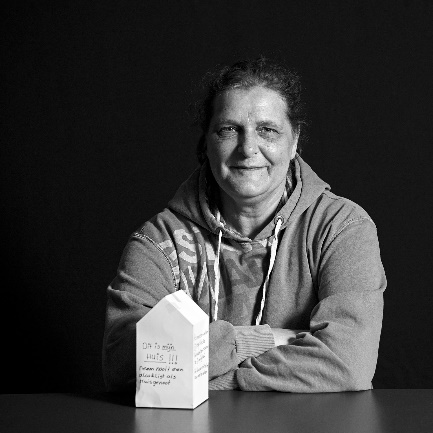
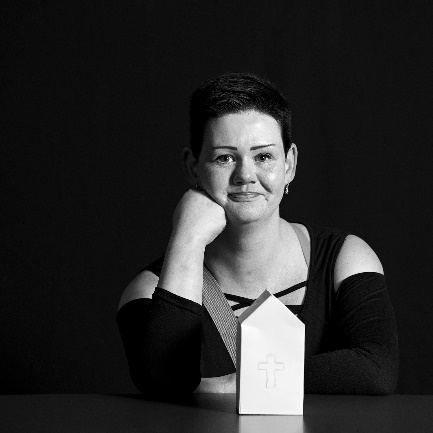
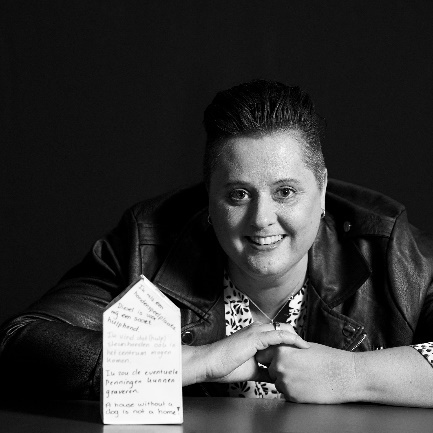
In Dronten, each group of stakeholders presented their houses (approximately 100 in total) in a theatre performance in which they voiced their opinions, wishes and experiences, supported by poems, photographs and collages. This way, stakeholders and residents of Dronten became aware of each other’s concerns. At the end of the performance, a collective house became visible, incorporating the various concerns: each group has its own colour and theme.
Figure 2 The themes of the different groups of stakeholders presented in one house and a speech given by the alderman of Dronten who expresses his commitment to the project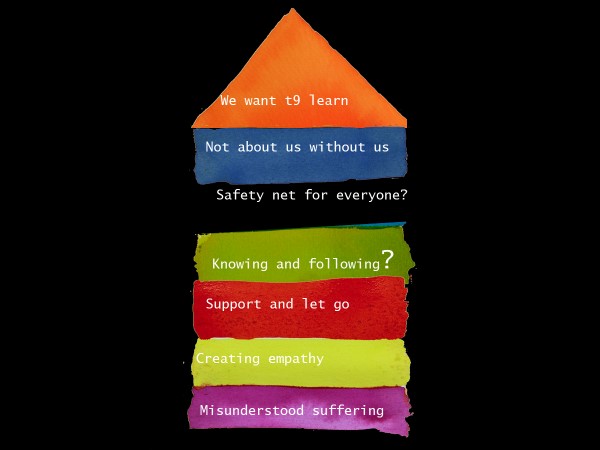
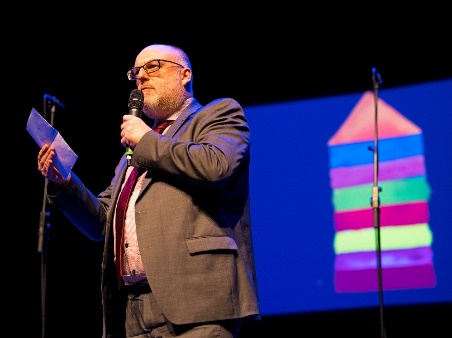
Phase 3: The theatre performance functioned as the kick-off for the living lab. In this living lab, stakeholders worked together on solutions and collective action. The voices of the people who have to move towards more independent living were given special attention: they were trained to stand up for themselves, in a process parallel to that of the lab. This kind of living lab, in which participants are truly co-creating, can also be seen as a ‘hot spot’ (Gratton, 2007). According to Gratton, true innovation can happen when different people and communities come together, are willing to cooperate and dare to cross boundaries, and the issue is urgent and inspiring. In such cases, untapped energy is released and a group of individuals becomes a hot spot in which change can happen and new knowledge is generated. In such cases, research becomes action research.
-
Arts-based participatory action research
We used an arts-based participatory action research design. Participatory action research (PAR) seemed appropriate, since its aim is to ‘make the system in which they [researchers] are doing research better’ (Abma et al., 2019: vii). PAR combines learning, transformative action and knowledge construction. Special attention is paid to encouraging socially marginalised people to have a voice. PAR can be seen as a relational, democratic and dialectical process, in which the process, products and results are intertwined. Three underlying principles of PAR are: 1) to maximise participation; 2) to enable people to take action; and 3) to add local value (Abma et al., 2019). In the following, we discuss how we incorporated these principles in this project.
1) To maximise participation
To achieve maximum participation, we as researchers did not keep our distance; instead we connected with the participants and worked together. Some of the people who had lived experiences with protected or supported living participated as co-researchers in the project. To achieve a connection between participants, and with us as researchers, we acknowledged the value of expressing emotions and made sure that we created a safe space to do so. Emotions are seen as knowledge that can have an impact on social change towards greater social justice (Pain et al., 2015). Involving everyone in everything is impossible, although during the research we were open to involving new persons and groups.
2) To enable people to take action
If the objective of a research project is to improve the system, as was the case with this project, it is important for the people within the system – and within the research project – to take action. To achieve this, as a researcher, you have to tolerate uncertainty – the researcher is not in control – and you have to have the guts to jump in, introduce your own feelings and ideas, and act as a catalyst. You have to welcome messiness, in which new connections and expressions can flourish. However, as Tina Cook (2009) mentions, this is not any kind of mess. It is a messiness that is needed to learn, it enables creativity to make space for change, focused on the project goals. It is not just chaos or ‘messing around’; instead it is about ’letting go of the ‘old’, being open to new words and realities, which turns the existing reality into a temporary mess’ (Cook, 2021).
One of the validity criteria of PAR is the notion of ‘catalytic validity’ (Lather, 1986): the research should energise people towards a more personal and closer knowledge of reality, in order to make new creative constructions to transform it. In short, PAR requires that you ‘give up what you think the research process should be’ (ibid.: viii). The municipalities were keen on this approach, acknowledging the fact that their usual structured policy processes were not producing the results they were hoping for. At the same time, they were anxious. They wanted us to be creative as well as methodical. Developing their trust in the unusual method we had proposed took some time.
When connecting with participants, building trust, developing ideas and sharing values and concerns, you have to be attentive to empowering processes. PAR implies action, even activism, especially when co-researchers come from disempowered communities (Abma et al., 2018: 119). So, in this project we paid extra attention to strengthening the voices of people with lived experience. We trained them to be advocates for people in similar situations, so their opinions and visions would be heard and appreciated in the larger group of participants. Besides the people with lived experience, this group consisted of representatives of the municipality, the housing corporation, and several care or welfare organisations, whose voices carry a risk of becoming overpowering.
3) To add local value
The most important way in which we added local value was by creating connections between stakeholders who had never met each other before, and had never worked together on an equal basis. Social workers, for example, listened to people with mental vulnerabilities as people with relevant experiential knowledge: their knowledge and experience was made explicit and re-evaluated; and formal organisations were connected with neighbours and the church.
Arts-based methods
In the social domain, arts-based research is an upcoming research strategy (Van Heijst et al., 2019; Leavy, 2020), in which practical, methodological, ethical and aesthetic criteria are intertwined. As a research team, we advocate for the combination of PAR with creative methods, using poems, photographs, paintings, theatre and music to express knowledge that is difficult to express. But what can the merits of using arts-based methods in research projects be?
For starters, arts are seen as an exceptionally good way to express and give meaning to worries and emotions (Groot et al., 2020; Van Heijst et al., 2019; Weerman & Abma, 2018). They can give expression to ambivalent meanings and the complexity of situations. As Patricia Leavy (2020: ix) writes: ‘The arts can uniquely educate, inspire, illuminate, resist, heal and persuade. It can reach people in a meaningful way’. In our project, arts-based methods were used to open up experiential knowledge of co-researchers that was difficult to articulate because of shame and stigma (De Jong, 2018; Groot et al., 2019).
Secondly, creative methods can ‘disrupt the usual’ (Abma et al., 2019: 115). The creative methods bring a broader pallet of knowledge that can inspire social change (Woodgate et al., 2017; Leavy, 2020). Arts-based framing of complex and ambivalent social situations can generate insights that go beyond the rational-cognitive way (Groot et al., 2020). As Vaart and colleagues (2018) mention, creative methods can bring a ‘spark among community members to engage in further action and contribute to the community’s resilience’. Creative action can give energy and a feeling of freedom and meaningfulness. Arts-based researchers are not ‘discovering’ new research tools, they are carving them’ (Leavy, 2020: 2). This matches well with the PAR process, in which learning and creating are key components.
Thirdly, arts-based research results can spark something in the audience, it can give a different, more ‘felt’ insight than the more traditional research reports can. Leavy (2020) notes: ‘While researchers often use the language of form or format to talk about the structure of research reports, I use the word “shape”. The word “shape” speaks to the form of our work but also to how the form shapes the content and how audiences receive that content’ (2002: 2). Artworks are meant to touch the heart (Leavy, 2020), to appeal to society to become more inclusive, for instance. The way the public perceives artworks matters. In our project, they should promote inclusivity and understanding.
These three merits can greatly contribute to the three underlying principles of PAR, with an emphasis on maximising the participation of people in vulnerable positions, and giving their voice an equal, if not a more prominent, role. Sometimes, in a later phase and if it has surplus value, the creative expressions can be articulated in language.
-
Reflection on the process: literally and metaphorically following dogs
The John Lennon quote ‘life is what happens to you while you’re busy making other plans’ can be applied to the process in Dronten: you start with a plan, but then things ‘happen’ that spark energy and emotion. Following these ‘hot topics’ might produce a lot more information and energy to take action on it, rather than rigidly sticking to the original plan, even if the ‘hot topic’ initially seems not to be strongly connected to the research topic. We further illustrate this with the example of ‘the dog’. We followed dogs in several ways: 1) ‘dogs’ were a metaphor for hot topics sparking energy; 2) the dog became a co-researcher who set out trails to more inclusive participation; and 3) the dog as a contribution to participation.
1) ‘Dogs’ as hot topics sparking energy
Naturally, we followed these hot topics, such as ‘the dog’, with a certain purpose: to contribute to empowerment and inclusion. We only followed ‘the dogs’ if they contributed to one of the four project goals. We started in an intuitive way, following the energy and connection that emerged.
Sometimes, ‘the dog’ faded away, following it led us nowhere. For example, some conversations that centred around the paper houses stagnated, or when asking about the neighbours the conversation halted. But, at other times, we were surprised. Suddenly, a detour along topics such as dogs, gardens, relocation, plants, church, forms or God, brought us towards new, and often more sensitive, topics that were related to the project. It sparked conversations in which experiential knowledge and undercurrents could surface.2) Dogs as co-researchers
Some of the researchers in our team (among them the first author) are professionals with experiential knowledge: they have mental disorders themselves or have received psychiatric treatment. One of them – Rose – is supported by an assistance dog: Rollo. Rollo keeps Rose in control and makes her feel safe. Rollo also accompanied Rose when interviewing and making paper houses with the people with lived experience. One of them – Simon – wrote on the floor of his paper house ‘I can’t live without my dog’. He did not talk that much, but when Rose showed interest in his dog Bella, who was not present during the interview, he picked her up and showed her to us. Bella and Rollo got along very well.
Figure 3 Simon is making a paper house, Rose and Simon with their dogs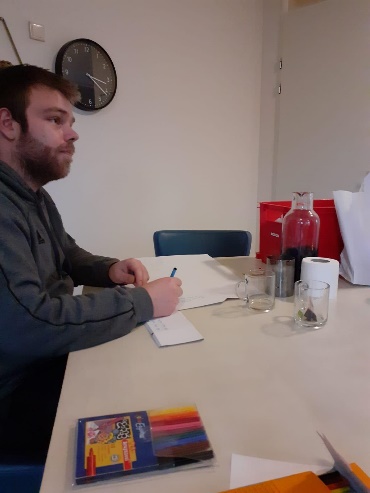
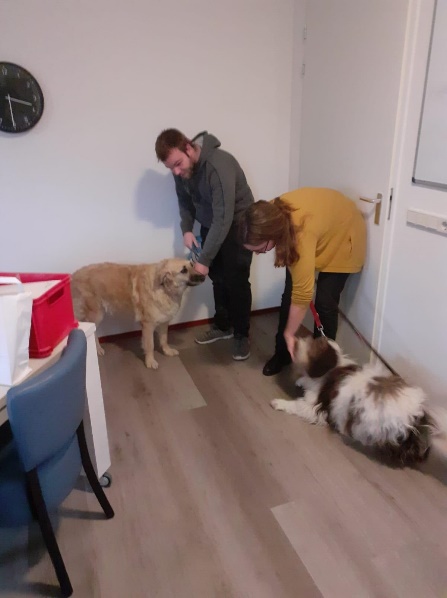
Back then, this incident did not spark our attention. We made appointments with other residents, some of whom had dogs, too. Some of the dogs intervened in our conversation, preventing us from focusing on the central subject: protected and independent living. The dogs jumping in would change the subject: instead of talking about housing, we talked about the dog. One of the interviews was cancelled because the dog was ill, so ‘I am not able to have an interview with you; maybe I have to quit my participation in the research because my dog has problems’.
After several of these incidents, we started to reflect on these experiences and situations, and we decided to not consider ‘the dog’ as a side issue: after all, the participants should be free to talk about issues they were concerned with when talking about protected or supported living in Dronten. We embraced ‘the dog’ as an issue; we took interest in the dogs. Surprisingly, this led to more commitment to the research project and to richer stories about participating as a resident of Dronten. Thus, following the dog (in this case literally) contributed to the maximisation of participation, one of the underlying values of PAR.
3) Dogs contributing to participation
The dog itself also appeared to support participation and inclusion. Along the way, we kept hearing stories about dogs, they popped up in every corner. All five people with lived experience we spoke to talked about the importance of their dog. They spoke of the dog with emphasis and emotion. After analysing the interviews and conversations, we were able to distinguish eight ways in which dogs contribute to participation and social inclusion:
Expanding the world: dogs make you go out.
Safety and holding: dogs can function as a ‘transitional’ or ‘holding’ object. It gives you a feeling of belonging and brings you ‘down to earth’.
Meaning: dog give you a daily duty;
Competence: you have to take responsibility, you have to care for your dog, raise and train it.
Channel fear of ‘normal’ people: some of the people we spoke to had a fear of ‘normal people’, as they called them. They felt ashamed about their vulnerability and their unusual behaviour. The dog made them feel more confident, and it gave a topic to have small talk with neighbours.
Addressing loneliness.
Soothe trauma and triggers: when traumas are activated, dogs can function as an anchor.
Staying in reality.
So we should see dogs from a social systemic perspective: they are part of the system of the person, just like partners, parents, loved ones, are. In mental health, they are mostly overlooked. But living with your dog also generates obstacles: it can be troublesome and difficult when dogs are not allowed in mental hospitals or protected living institutions. We heard one striking example from Harry and Marja. They are spouses but they live apart, and they each have a dog. When Harry has to go to a hospital, it is not possible for Marja to look after Harry’s dog, Amy, because only one dog is allowed in her apartment.
Additionally, the focus on dogs initiated a policy change. In Dronten, dogs are not allowed in the centre of town. So, we talked to Anny, policymaker of the municipality, who was made aware of the implications of banning dogs. Thus, following the dog taught us and other stakeholders the importance of dogs for independent living, and it initiated a policy change that increased the social inclusion of independently living residents with mental problems. In this sense, following the dog contributed to taking action and to adding local value.
-
Constructing meaning in art-works
As mentioned earlier, in this project we combined PAR with arts-based methods. Besides incorporating the making of paper houses in our interviews, as explained and illustrated above, we used two additional artforms: 1) we took professional photos of clients and their dogs; and 2) we translated the stories and visions into collages. Below, we explain the merits of these two artforms in this project.
1) Dogs in frame
During the process, we developed the idea to make professional – aesthetically valid – portraits of the dogs, asking their owners to also be in frame. Aesthetic validity has to do with representing the experiences, situations and interests of the participants in a respectful, ‘true’ way that touches you, and facilitates empathy and empowerment (Van Heijst et al., 2019). In consultation with the professional photographer and the co-researchers, all these photographs are shown in a black-and-white version, to give an expression with impact. The focus was, at least in the beginning, mainly on the dog. For those dog owners who were still hesitant, this felt safe, which enabled us to slowly get to know the owner behind the dog and hear their stories. The dog owners felt acknowledged and respected because of the aesthetic and professional quality of the photographs. The photographs were exhibited in several public buildings in and nearby Dronten.
Figure 4 Several experiential experts with their dogs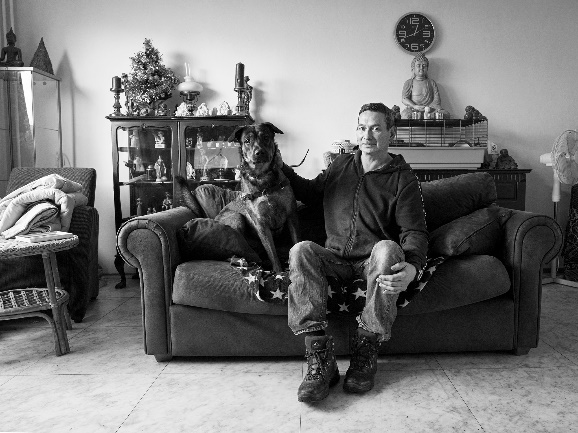 Harold and Amy
Harold and Amy 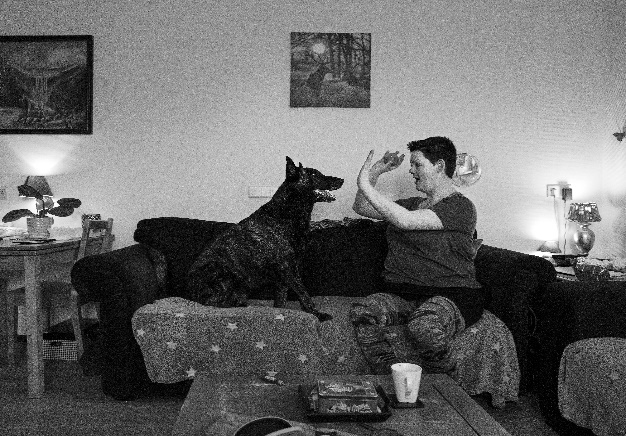 Marja and Johnno
Marja and Johnno 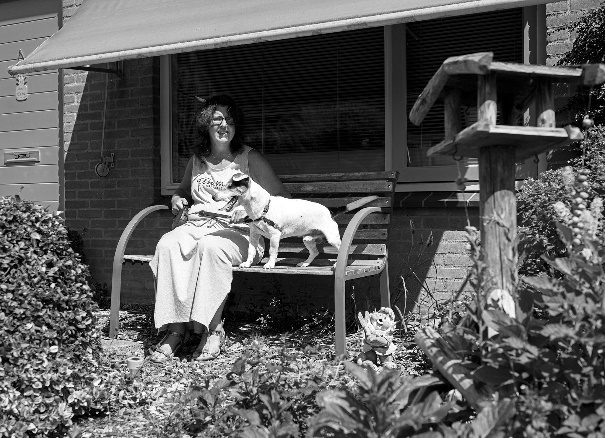 Marielle and Milo
Marielle and Milo 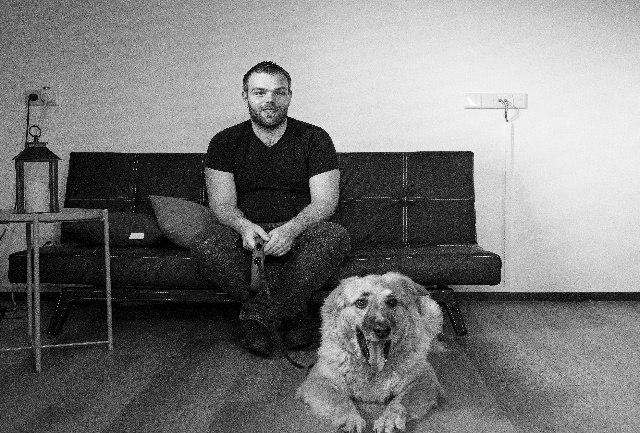 Simon and Bella
Simon and Bella 2) Collages and poems to tell stories
Rose, the arts-based researcher in our team, is also an artist. She made collages and poems of the stories in collaboration with the people in the project. She made artworks of Marja’s and Harry’s stories in a dialectial way, by discussing the works with them. Harry and Marja were very touched by the collages and the poetic editing of their stories. The artworks and poems can be seen as empowerment and knowledge construction. They give expression to the experiences and complex situations of the people involved. The artworks were shown in the theater performance in Dronten in addition to the text Marja herself read out loud.
The artworks also represent more general issues that we found in working with the co-researchers, for instance: fear of loneliness and stigmatisation, and ambivalence towards living on your own. The artworks can facilitate empathy and insight in the lifeworlds of the people in question.
Figure 5 Art works reflecting issues of people moving from protected living to the neighbourhood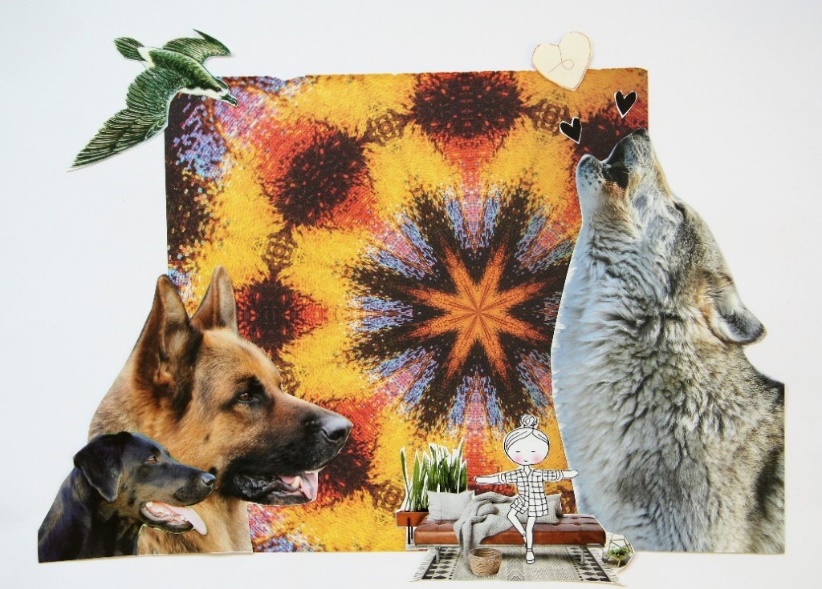 A butterfly on the background
A butterfly on the background
A kaleidoscopic picture
She meditates; pictures in the head
The wolf is scary!
Or related to the dogs that provide safety?
Are the dogs safe?
Two dogs at the same time is problematic
The wolf weeps love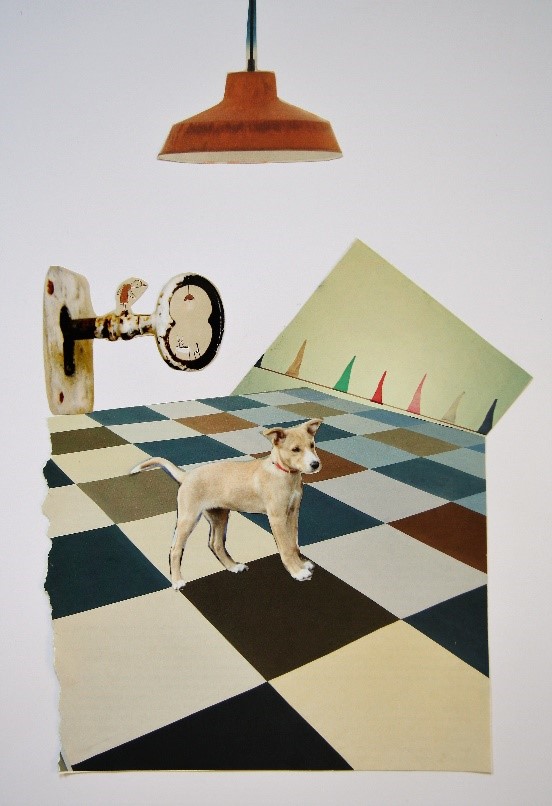 A key for a house of your own
A key for a house of your own
Party flags upside down:
Is this really an improvement?
It is empty,
There is loneliness and fear
Fortunately the dog is there too! -
Reflection on the research goals
An important question to ask is: to what extent does this arts-based PAR approach allow us to reach our project goals? The project is still running, but we can give a short reflection on this:
1) Explicating the experiential knowledge of living with a mental vulnerability in the community
This took shape in several ways. The participants with lived experience shared their stories on stage during the performance, in front of a large audience. Additionally, they voiced their experiences, opinions and preferences during the meetings in the living lab. During the training, they were taught, supported and encouraged to act as advocates. As a result, they will continue to act as a group of advocates, for example, giving advice on the readability of official forms, and collaborating on the design and content of a new activity centre.
2) Letting the unspoken surface in ways other than by language, i.e. using arts-based methods
In this paper, we displayed several ways in which we used art to express emotions and experiences: the paper houses that showed all the different perspectives and stories concerning the topic of the project; the professional photographs that featured our participants with mental vulnerabilities in a strong and beautiful way, with their dogs or in their gardens; and the collages, made by our arts-based researcher, that expressed how complex and multi-layered the experiences of people with mental vulnerabilities can be. Other stakeholders mentioned the impact of these presentations: they made them more aware of meaningful aspects and the complexity of the lifeworld of citizens with mental vulnerabilities.
3) Initiating transformative action focused on empowerment and inclusion of citizens with mental vulnerabilities
We worked towards this goal by initiating and preserving new connections, especially between participants with mental vulnerabilities and formal parties. By stimulating them to communicate on a more equal level than they were used to, they discovered new things about each other. Ruud, one of the participants with a mental vulnerability, said the following on this subject: ‘What happened in Dronten is that I got to see the (experiential) world of the people who work with those – to me god awful – forms, protocols and rules. The problems they encountered. That was new to me, and it deepened my insights. This insight into each other’s worlds is important. It made me more understanding and respectful. Instead of standing opposite each other, we ended up next to each other. That is so valuable!’ The civil servant from the Municipality of Dronten responded with the following words: ‘It opened my eyes. Processes can take the upper hand, making the human side disappear into the background. Ruud’s words made me see that again. We need to keep talking to each other like this’. One of the social workers added: ‘This really gave me some awareness. I really enjoy meeting each other in town and being able to relate to their state of mind. There is complete understanding, there is a real connection.’
4) To create a collaborative learning environment in the municipality in which stakeholders, including those with lived experiences, can work together
We created this collaborative learning environment by organising living labs in which new collaborations and products could be created. This resulted in, for instance, the process of co-designing a new recovery centre, adjusting official forms, and co-creating stories that give insight into the complexity of living with mental vulnerabilities. One of the policymakers said: ‘It is very important to listen to the stories of others; facts and rules are not the only thing!’
-
Discussion: reflecting on method, ethics and process
Follow the dog means: setting up a structure together, then following the unexpected while managing it in transformative action and creating new narratives. PAR is guided by a set of ethical principles: mutual respect, equality and inclusion, democratic participation, collective action and personal integrity (Abma et al., 2019: 86). Arts-based methods can give expression to practical and existential knowledge, enhance democratic participation and reveal new meanings (Weerman & Abma, 2018). They can give voice to experiences and issues that are difficult to express in language. They can reveal worlds and facilitate empowerment and inclusion. However, this process is complex and we encountered several issues, on which we reflect in the following section.
Focus on the unexpected
Most action researchers describe PAR as ‘cyclical’ (Abma et al., 2019: 138). In our project, we are not so much working in a cyclical way, but rather in an organic way. In social work and social policymaking, the focus lies mainly on social problems that present themselves and the people who encounter these problems. The importance of flora and fauna, but also of other unexpected and unpredictable aspects in people’s lifeworlds, is still easily overlooked. In following the dog, we worked with PAR in the messy real world, including nature, including animals, including the whole ecological system in which people live. Yet, while expressing and constructing new meanings can create new possibilities and connections, it can also easily sediment into fixed frames of reference. ‘Dogs’ need to be on the move and transform into new creatures and topics, to do justice to the dynamic processes of the lifeworld. We need to remain aware of the risk of developing new blind spots and constructing a rigid focus, in this case on ‘the dog’. To give an example: when taking professional photographs of the dogs and their owners, one of the participants did not have a dog anymore. He is a gardener. He invited all members of the training group into his garden, and talked vividly about creating and taking care of his vegetable garden. This topic also appeared to function as an energiser, and being together in the garden contributed to the cohesion of the group. We asked our photographer to make a portrait of Ruud in his garden as part of our series of the dogs in Dronten. At first there was hesitation, because the topic differed from the other photographs. It seemed to disturb the aesthetic quality of the neat set of photographs that were exhibited. But ‘following the dog’ also means doing justice to different lifeworlds, and following the energy.
Combining PAR with arts-based research
We worked with PAR in an arts-based way, which raises specific questions. Van Heijst et al. (2019) formulated four quality criteria to evaluate arts-based research, namely methodological quality, practical quality, ethic quality and esthetic quality. In our case, the methodology was PAR, which has its own criteria. When combining the PAR criteria mentioned above (Abma et al., 2019) with the arts-based criteria, we were confronted with quality issues. The acknowledgement of aesthetic criteria is especially new to us and to research in general. We noticed the power of this dimension, but also the risk of giving this dimension priority over ethical criteria, as we showed in the section above explaining the aesthetic value of professional photographs.
To give an example: we decided to hire a professional photographer to take the dog pictures, to do justice to the dog owners and make them feel worthy and empowered. This resulted in such high-quality photographs that we were asked to present them in an exhibition. The persons in the pictures felt encouraged and respected by this, and they became stronger and more confident advocates. However, when it came to choosing the designated photograph for the exhibition, a difference of opinion between the photographer and the person in the picture did occur sometimes. In such cases, we let the person’s opinion prevail. We started a conversation between photographer and the person with a mental vulnerability, so they could both learn to articulate their own perspective while listening to the other’s. This was a new perspecive for the photographer who was used to being in charge of aesthetic issues. In our opinion, this was crucial from an ethical PAR perspective. After all, the artwork can not be impactful unless it can be used for social action, and to do so, all parties should feel comfortable with the end result.
Combining the lifeword with the system world
In the first phase of the project, it took some effort to convince policymakers that applying PAR, combined with arts-based methods, was a good choice. We needed to build trust and soften resistance to the chaotic way we seemed to work. The policymakers asked us to operate in the lifeworld, but at the same time they wanted us to combine this with the formal systems at the municipality. We managed to convince them by organising commitment from a great number of stakeholders who – using a ‘snowball’ method – became part of the project. We then worked out a clear structure and organisation for the project. Within this structure, we organised the necessary space to go with the flow. In Dronten, this resulted in the policymakers participating in the theatre performance with an arts-based presentation of their own. It was fun and we made our point! Still, policymakers time and time again have to overcome their restraint towards an organic way of doing research, even if they have the strong wish to do so.
Strengthening the weaker voice is hard work
Working as participatively as possible is hard work, as is doing justice to a variety of ‘worlds’ and perspectives. But it is even harder to actually give priority to the voices of those who need support, which is an explicit goal of PAR. Our aim was to value experiential knowledge as ‘the first souce of knowledge’, by paying special attention to articulating this knowledge. Still, even in our own research group there was a discussion about the position of this knowledge: sometimes it is difficult to articulate it, it takes a lot of time and it is difficult to express. Some of our researchers were impatient, things are easier and go faster without those ‘slow and vulnerable people’. The fact that some of the researchers in our own team have experiential knowledge themselves is of great importance here. They have two different merits: 1) they are able to connect to people with mental vulnerabilities in a ‘tacit’ way and have a special receptivity for their knowledge; and 2) they can help steer the rest of the research group through the ‘swampy lowlands’ of the lifeworld of people with mental vulnerabilities. A result of the constant focus on strengthening the weaker voice is the fact that, after the project, the co-researchers further developed as a group of experiential experts acting as spokespersons for citizens with mental vulnerabilities. They learned to stand up for their interests and needs.
Dealing with uncertainty
Acting for change is unpredictable and often we cannot know how the actions will affect the way changes manifest. Following the dog seems easy – go with the flow – but is very difficult for researchers who like to be in full control and work with settled plans. Not every researcher can handle the uncertainty this brings. In our team, one of the researchers was not comfortable with ‘following the dog’. She wanted to be more in control and act on pre-set plans. However, as a PAR researcher you cannot be in full control of the process. Control is always shared, and messiness is not only inevitable but also necessary and purposeful. As Tina Cook (2009) emphasises, we should plan for messiness: ‘It is the driving force for revealing tacit or hidden realities that frame action’. Certain kinds of mess enhance the transformative powers of a participatory research approach.
Balancing local and general aspects
In this project, we needed to balance overarching aspects with local aspects. We work with small groups in specific municipalities, but the project as a whole has a large scope, covering an entire province. This dual structure was needed to empower changes on a small local scale, on the one hand, and on connect learning experiences in different locations with each other, on the other hand. Small-scale interventions – like the one with the dogs – can give leverage to more widespread changes within formal systems. According to Abma et al. (2019) action can be ‘like a small pebble thrown in a pond, the effects ripple out to the edge and even beyond…’. However, to connect local interventions with interventions elsewhere requires a lot of reflection and translation to a different local context.
-
Conclusion
By ‘following the dog’ we let go of our own frame of reference while following topics that popped up spontaneously and that were relevant for changes towards inclusion, meaningfulness and increased social justice. We chose to accept the messiness of the natural world in which human lifeworlds are embedded, and we widened our viewpoint in collaboration with co-researchers.
However, following the dog is not only about dogs, it is about doing justice to the lifeworld and giving voice to marginalised groups. We realised that there is the need to keep re-inventing ‘following the dog’, and refrain from fixating on one frame of reference: in a different context, a different topic might function as catalyst in transformative action. We also realised that participative action research needs a lot of ‘ethics work’ (Banks, 2016) to consider the dignity, equality and power relations. And, when adding an arts-based component to PAR, aesthetic criteria should be balanced with ethic ones; aesthetic criteria should serve the values that are at stake.
Arts-based participatory action research, just as life, is what happens while you’re busy making other plans. Set up a structure together, and then follow the unexpected; manage the unexpected in transformative action and new narratives. In our project, we discovered that this seemingly ‘messy’ method could still result in working steadily towards reaching our research goals, especially since these goals were well aligned with the PAR method. Keep your goals in mind, but let yourself be surprised by the path that leads towards them.
Note: Some of the names of experiential experts on the photographs are changed for privacy reasons. Harry, Marja and Simon are pseudonyms.
Figure 6 Aly, Roos and the dog Rollo visiting Ruud in his garden to talk about co-creation in the project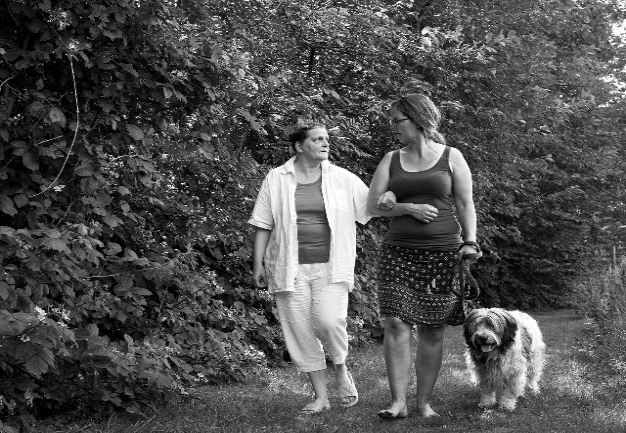
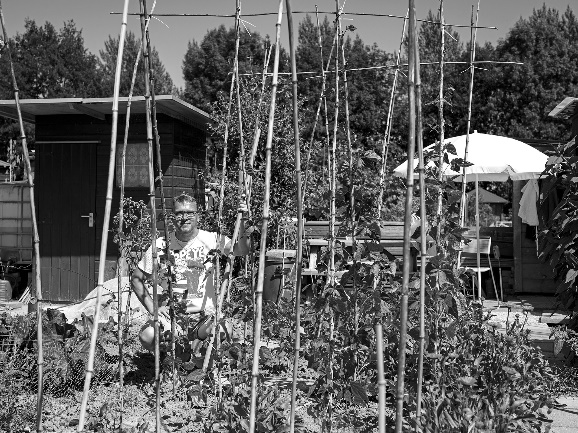 References
References Abma, T., Banks, S., Cook, T., Dias, S., Madsen, W., Spingett, J., & Wright, M. (2019). Participatory research for health and social well-being. Springer Nature Switzerland.
Banks, S. (2016). Everyday ethics in professional life: Social work as ethics work. Ethics and Social Welfare, 10(1), 35-52.
Cook, T. (2009). The purpose of mess in action research: Building rigour though a messy turn. Educational Action Research, 17(2), 277-291.
Cook, T. (2021). Participatory research: Its meaning and messiness. Beleidsonderzoek Online, februari, DOI:10.5553/BO/221335502021000003001
Dannenberg, E. (2015). Van beschermd wonen naar een beschermd thuis. Adviescommissie Toekomst Beschermd Wonen, Vereniging Nederlandse Gemeenten.
De Jong, K. (2018). Ervaringsdeskundigheid vraagt om creatieve vormen van kennisontwikkeling. Participatie en Herstel, 4, 21-29.
Groot, B., Overbeek, F.J., Abma, T., & Weerman, A. (2019). Het onzegbare uiten. Participatie en Herstel, 2, 12-20.
Groot, B., Weerman, A., Overbeek, F., & Abma, T. (2020). Making a difference: Participatory health research with unemployed citizens and policymakers. International Review of Qualitative Research, 1-19.
Lather, P. (1986). Research as praxis. Harvard Educational Review, 56(3), 257-278.
Leavy, P. (2020). Method meets art: Arts-based research practice. New York/London: The Guildford Press.
Pain, R., Askins, K., Banks, S., Cook, T., Crawford, G., Crookes, L., Darby, S., Heslop, J., Holden, A., Houston, M., Jeffes, J., Lambert, Z., McGlen, L., McGlyn, C., Ozga., J., Raynor, R., Robinson, Y., Shaw, S., Stewart, C., & Vanderhoven, D. (2015). Mapping alternative impact: Alternative approaches to impact from co-produced research. Produced as part of the N8/ESRC Research Programme Knowledge that Matters: Realising the Potential of Co-Production. http://www.dur.ac.uk/resources/beacon/Mapping/AlternativeImpactsummaryfinal.pdf
Vaart, G.V.D., Hoven, B.V., & Huigen, P.P. (2018). Creative and arts-based research methods in academic research: Lessons from a participatory research project in the Netherlands. Forum: Qualitative Social Research, 19(2), 30.
Van Heijst, P., De Vos, N., & Keinemans, S. (2019). Arts-Based Research voor het sociaal domein. Bussum: Coutinho.
Weerman, A., & Abma, T. (2018). Social work students learning to use their experiential knowledge of recovery: An existential and emancipatory perspective. Social Work Education, 1-17.
Woodgate, R.L., Zurba, M., & Tennent, P. (2017). A day in the life of a young person with anxiety: Arts-based boundary objects used to communicate the results of health research. Forum Qualitative Sozialforschung / Forum: Qualitative Social Research, 18(3), Art. 17.
Citeerwijze van dit artikel:
Alie Weerman en Rosalie Metze, ‘‘Follow the dog’ – Creating arts-based, supportive and relational spaces to facilitate in a purposeful discovery of knowledge’, 2021, juli-september, DOI: 10.5553/BO/221335502021000005001
Beleidsonderzoek Online |
|
| Artikel | ‘Follow the dog’ – Creating arts-based, supportive and relational spaces to facilitate in a purposeful discovery of knowledge |
| Auteurs | Alie Weerman en Rosalie Metze |
| DOI | 10.5553/BO/221335502021000005001 |
|
Toon PDF Toon volledige grootte Samenvatting Auteursinformatie Statistiek Citeerwijze |
| Dit artikel is keer geraadpleegd. |
| Dit artikel is 0 keer gedownload. |
Alie Weerman en Rosalie Metze, '‘Follow the dog’ – Creating arts-based, supportive and relational spaces to facilitate in a purposeful discovery of knowledge', Beleidsonderzoek Online juli 2021, DOI: 10.5553/BO/221335502021000005001
|
Dutch social policies are aimed at the integration and participation of all people. This creates challenges for persons with a mental vulnerability and their neighbourhoods. Five municipalities in the province of Flevoland asked us to help them improve the move from protected living to living in the neighbourhood. We used an arts-based participatory action research design and we followed ‘hot topics’, topics that sparked people’s energy and emotion, and which led to empowerment and participation. Focusing on these topics, which initially might not seem to be closely connected to the main research topic, might produce more information, and energy to take action on it, rather than rigidly sticking with the initial research topics. In this article, we focus on the first phases of the project. The emotions that people with mental vulnerabilities expressed when talking about their dogs, led us to the core of what really mattered to them in terms of inclusive living and participation. The dog functioned as an unexpected ‘hot topic’. In a symbolic sense, ‘the dog’ stands for a diverse range of lifeworld topics that can act as a creative catalyst for social change. Vooraf Participatief actieonderzoek en responsieve evaluatie staan volop in de belangstelling bij beleidsmakers en onderzoekers. Dit type beleidsonderzoek en -evaluatie beoogt democratisch, inclusief én impactvol te zijn. Het gaat om onderzoek mét in plaats van óver mensen. En het is actiegericht: onderzoek wil bijdragen aan concrete oplossingen door met betrokkenen gezamenlijke (verbeter)acties te ontwikkelen in de praktijk, en daarop te reflecteren en van te leren. Dit alles met het oog op sociale inclusie. Het zijn mooie idealen, maar wat betekent dit in de alledaagse, vaak weerbarstige onderzoekspraktijk? Op 20 januari 2020 organiseerde prof. Abma daarover een symposium, getiteld ‘Responsive, Participatory Research: Past, Present and Future Perspectives’ (Vrije Universiteit, Amsterdam). De rode draad op het symposium was de vraag wat goed en ethisch verantwoord participatief onderzoek is, en wat dit vraagt van onderzoekers en beleidsmakers. Drie lezingen op deze conferentie zijn nadien omgewerkt tot essays om lezers van Beleidsonderzoek Online vanuit verschillende perspectieven beter kennis te laten maken met deze vorm van onderzoek: Prof. Weerman en haar team focussen in hun bijdrage op het zich in de praktijk ontwikkelende onderzoeksdesign en het inzetten van creatieve methoden om participatie te bevorderen. Ze gaan na welke kwaliteitscriteria aan participatief actieonderzoek worden gesteld en hechten daarbij met name aan eisen ten aanzien van participatie, samen leren en verschil maken (zie BoO juli 2021). Ze benadrukken het belang van creativiteit en flexibiliteit. Prof. Abma bespreekt in haar artikel de normatieve dimensies en de ethiek van participatief actieonderzoek (zie BoO september 2020). Ze illustreert met een voorbeeld uit de crisishulpverlening aan GGZ-cliënten dat participatief actieonderzoek niet slechts een methodisch-technische exercitie is, maar een sociaal-politiek proces waarbij bestaande machtsverhoudingen verschuiven om ruimte te geven aan nieuwe stemmen en kennis. Dit omvat het zien van en stilstaan bij ethisch saillante dilemma’s en morele reflectie. De bijdrage van prof. Cook (zie BoO februari 2021) gaat over de weerbarstige praktijk van participatief actieonderzoek. Het doel is samen leren en voorbij geijkte oplossingen komen. Zij laat zien dat dit uitdagend is voor professionals die geconfronteerd worden met burgers die feedback geven en vragen om het (deels) loslaten van vaststaande professionele kaders. Er ontstaat dan ongemak en onzekerheid, maar zo beoogt en laat Cook overtuigend zien, deze ‘mess’ (niet meer goed weten wat goed en nodig is) is productief om te komen tot hernieuwde inzichten en innovaties. (Introductietekst opgesteld door prof. T. Abma) |
Dit artikel wordt geciteerd in
- Abstract
- Introduction
- Context of the project
- The first three phases of the project
- Arts-based participatory action research
- Reflection on the process: literally and metaphorically following dogs
- Constructing meaning in art-works
- Reflection on the research goals
- Discussion: reflecting on method, ethics and process
- Conclusion
- References
- ↑ Naar boven

